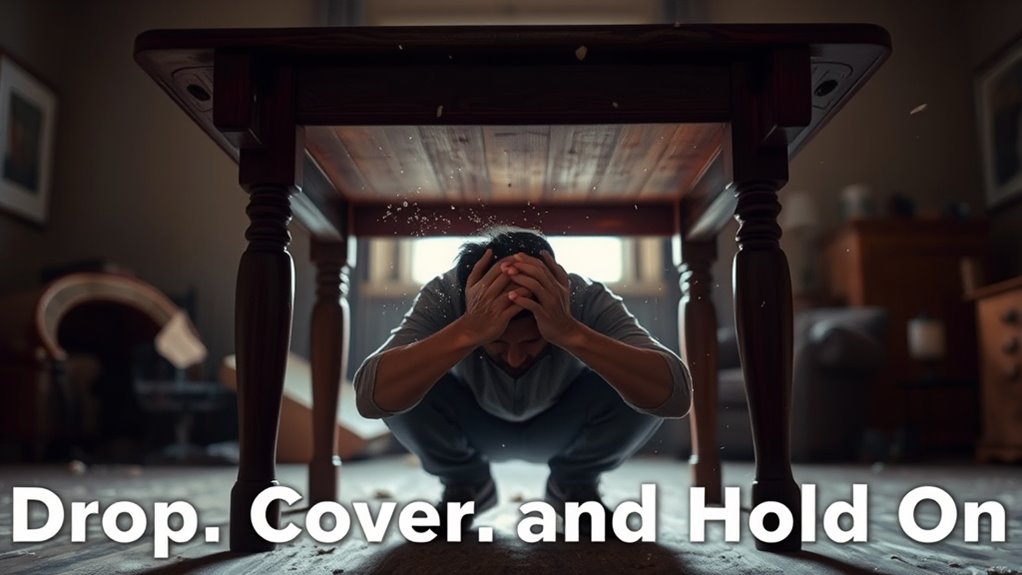During an earthquake, your best move is to immediately drop to the ground, take cover under sturdy furniture or in a safe spot, and hold on until the shaking stops. This “Drop, Cover, and Hold On” technique protects you from falling debris and injury. Staying calm and acting quickly can save your life. Want to know how to prepare better or practice this method? Keep going to learn more about staying safe during quakes.
Key Takeaways
- Immediately drop to the ground, take cover under sturdy furniture, and hold on until shaking stops.
- Practice the “Drop, Cover, and Hold On” technique regularly through drills to build quick, instinctive responses.
- Seek shelter in safe spots like under desks or against interior walls away from windows.
- Seismic early warning systems can provide crucial seconds to prepare and execute safety measures.
- Secure heavy furniture and loose items at home to reduce hazards during an earthquake.

Earthquakes can strike unexpectedly, causing damage and danger in seconds. When the ground begins to shake, your immediate response can make all the difference. That’s why understanding and practicing the “Drop, Cover, and Hold On” technique is essential. It’s the safest way to protect yourself during an earthquake, and knowing what to do can reduce injuries and even save lives. But before an earthquake hits, there are proactive steps you should take, like participating in earthquake preparedness drills and paying attention to seismic early warning systems. These tools and practices prepare you to respond swiftly and confidently when seconds matter most.
Seismic early warning systems are designed to detect initial seismic waves before the more destructive waves arrive. These alerts give you precious seconds to drop to the ground, take cover, and hold on. It’s a simple yet powerful way to reduce the risk of injury if you’re in a building or near windows, shelves, or other hazards. When you get an alert, don’t wait—immediately follow the “Drop, Cover, and Hold On” procedure. This quick reaction can protect your head and vital organs from falling objects and debris. It’s essential to stay updated with local alerts and know how your community’s seismic early warning system works. Proper storage of emergency supplies can also make a significant difference in your safety and comfort during and after an earthquake.
Participating in earthquake preparedness drills is another critical step. These drills simulate real earthquake scenarios and help you practice your response. Regular drills build muscle memory, so when an actual earthquake occurs, you won’t panic or freeze. Instead, you’ll instinctively drop to the ground, find cover under a sturdy piece of furniture, and hold on until the shaking stops. When your community or workplace conducts these drills, take them seriously. They’re designed to help you understand what to do, identify potential hazards in your environment, and ensure everyone knows how to respond effectively.
Preparing your home is equally important. Secure heavy furniture, fix loose items, and identify safe spots in each room. When you combine this preparation with knowledge of seismic early warning and participation in drills, you’re creating a thorough safety plan. Remember, the key to earthquake safety lies in quick, calm action. The moment you feel the ground shake, don’t hesitate—drop, cover, and hold on. Your preparedness, awareness of early warning alerts, and regular drills will help you stay safe, minimizing injuries and chaos during an unpredictable event.
Frequently Asked Questions
How Effective Is the Drop, Cover, and Hold on Method?
The drop, cover, and hold on method is highly effective in reducing your risk during seismic impact. It helps shield you from falling objects, debris, and structural damage, minimizing injury. In emergency response situations, practicing this technique ensures you’re prepared to stay safe until the shaking subsides. By staying low, taking cover, and holding on, you increase your chances of avoiding serious harm during unpredictable earthquake events.
What Should I Do if I’m Outdoors During an Earthquake?
Ever wonder what to do when you’re outdoors during an earthquake? First, move away from outdoor hazards like trees, power lines, or buildings that could fall. Drop to the ground, take cover behind a sturdy object if possible, and hold on until shaking stops. Keep emergency contacts handy, and once safe, check for injuries and hazards, then report damages or hazards to local authorities. Stay calm and stay safe.
How Can I Prepare Children for Earthquake Safety Procedures?
You can prepare children for earthquake safety by teaching them simple, clear instructions about drop, cover, and hold on. Practice emergency communication with them, so they know how to reach loved ones and authorities if separated. Emphasize child safety by creating a family plan, using visual aids, and reassuring them that they can stay safe by following procedures. Regular drills build confidence and guarantee they respond calmly during an actual quake.
Are There Specific Safety Tips for Elderly or Disabled Individuals?
You should prioritize senior safety and mobility assistance during earthquakes. Help elderly or disabled individuals prepare by arranging accessible shelter spots and ensuring they know how to safely drop, cover, and hold on. Keep mobility aids nearby, and consider creating a personalized emergency plan. Offer ongoing support and practice drills together so they feel confident and secure in executing safety procedures quickly and effectively.
How Often Should Earthquake Drills Be Practiced at Home?
You should practice earthquake drills at home at least twice a year to guarantee your emergency preparedness. Regular drills help you stay calm and know exactly what to do during an earthquake, strengthening your home safety. During each practice, review drop, cover, and hold on techniques, and make adjustments for any mobility needs. Consistent practice keeps your response quick and effective, reducing chaos and injury when an actual quake occurs.
Conclusion
Remember, during an earthquake, your actions are like anchoring roots in a shifting world. Drop, cover, and hold on are your steadying hands, guiding you through chaos. Just as a lighthouse stands firm against turbulent seas, your preparedness becomes a beacon of resilience. Embrace these steps as your shield, symbolizing strength and hope amid uncertainty. Stay calm, stay safe—your vigilance lights the way through life’s unpredictable tremors.










